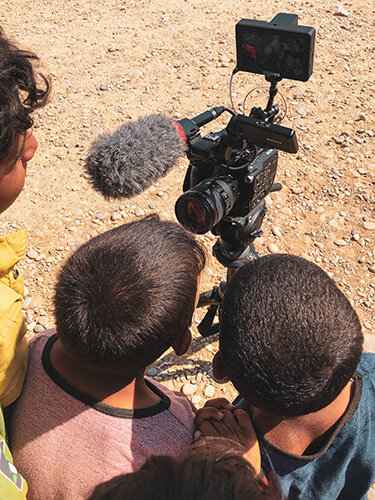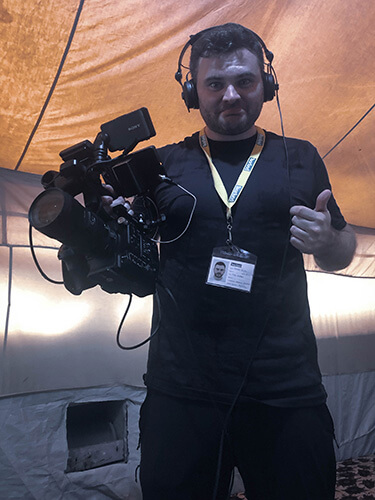VOICE-OVER OR SUBTITLES – Which is Best for Your Charity Video?
This is an ongoing debate when it comes to making films with foreign languages more accessible, voice-over or subtitles.
To be clear, dubbing is the technique that replaces an interviewee’s original voice with an english voice-over and subtitling is the process of placing translated words at the bottom of the screen. The goal of both is to make your video as accessible as possible and each method has pros and cons. Which is right for your project will depend on how you plan to use the video and how your audience will be viewing it.
PROS OF VOICE-OVER
- Voice overs provide audio in the native language and allow you to create an engaging experience.
- It allows viewers to concentrate on the video content, and they don’t get distracted by reading the text.
- You can adjust the speed of people speaking and can make it easier for your audience to understand.
- You can translate complex language and contextualise the translation to make it more accessible for your intended audience
CONS OF VOICE-OVER
- Finding the perfect person to deliver the right style and tone of voice-overs for your subject can be a challenge.
- It is more expensive than adding subtitles.
- Recording voice-overs is a longer process and requires a longer turnaround.
- It is less natural or authentic than hearing the persons actual voice telling their story.
PROS OF SUBTITLES
- Subtitles allow viewers to listen to the way people communicate, to authentic voices and is therefore more natural.
- The authenticity of subtitles can be more immersive for a viewer
- It is a faster process than dubbing if working to a tight deadline.
- Subtitles are cheaper and therefore more suitable for tight budgets.
- They can provide clarity for technical terminologies.
- You can offer content in a variety of languages.
- When used on social platforms with the audio muted viewers can still follow the story and be drawn into the video.
CONS OF SUBTITLES
- They may distract the viewer’s attention from the footage.
- They take up screen space, they may cover important parts of your footage
- Poorly done subtitling can create confusion.
- The pace of the talking can mean the text is not on screen for long enough. Therefore this has to taken into consideration and affect the pace of the actual edit
PROJECT CASE STUDY
I’ll illustrate each approach with the help of a real project case study;
Tearfund are long standing clients who do incredible work empowering people and communities around the world to lift themselves out of poverty. They commissioned me to tell the story of how families in Iraq have been impacted by conflict and are being supported by Tearfund partners.
During this 10 day assignment I met Abeer and her young family. She explained how they fled home in fear and are now living in a temporary camp, struggling to get the basic essentials they need to survive. We spent a few hours together capturing their story in sweltering 40 degree heat.
For the interview I used a lavalier (lapel) mic to ensure her voice was recorded clearly. Even when using voice-overs it is important to hear the person’s real voice to give a sense of authenticity. Therefore, I only introduce a translated and recorded voice-over after the subject has been clearly established.
Another important tip is using a voice-over artist in keeping with the original style and tone. That means using someone with a similar accent and demographic to your subject to convey the original context as much as possible. Television news reports often use western accents because it is just faster and easier, but this always jars and creates a disconnection from the story. Even a voiceover without the right emotion or tone will feel inauthentic and therefore less engaging.
Tearfund’s original brief was to create a short video for their social media. Their social media strategy for facebook and instagram is to use subtitles and this film is the result.
Subtitled Film
Tearfund then wanted the story repurposed for their lent appeal and was shared by churches during online services. Tearfund’s policy for event screenings is to use both voice-over and subtitles to ensure the film is accessible for everyone. So here is a slightly re-edited film with voice-overs added for your comparison.
Dubbed & Subtitled Film
TRANSLATION
Whether you choose to subtitle or add a voice-over to your video project, you’ll need a trained translator to come up with a good version of the original interview. The golden rule is authenticity but again there are two approaches; literal or creative translation.
Literal translation is the simplest type of translation, it takes existing content in one language and translates it word-for-word into the new language. While creative translation takes into account the context of the source content, making sure that the translation doesn’t just make sense from a linguistic point of view, but also from the cultural perspective of the target language. You can read more about these different approaches but authenticity is fundamental.
A glimpse behind the curtain at my subtitling process.
CONCLUSION
Factors like your production schedule and budget have to be taken into consideration. In addition to translation, dubbing requires professional voice overs (one for each person in the video) so the cost of subtitling will be lower. Turnaround is faster when using subtitles without the need of recording and editing. But your decision should be determined by your target audience.
When choosing the right method of translating videos, you need to consider how people are going to be watching. Will it be easier for them to engage without having to read the subtitles. Or if they are viewing on social media will subtitles draw them into a video which is initially displayed in a feed on mute.
There is no right or wrong answer in this debate but in order to make your video as accessible as possible, the answer may be to utlise both subtitles and voice-over.
Useful resources
I have commissioned numerous agencies and independent translators / voice-over artists over the years. Here are a few links you may find useful;






